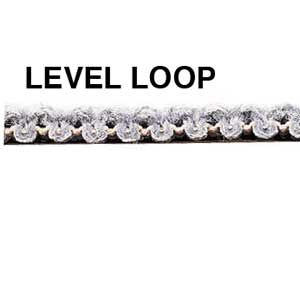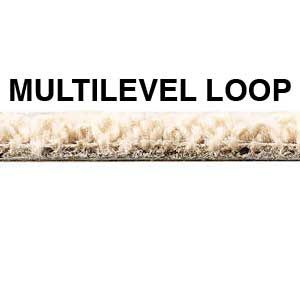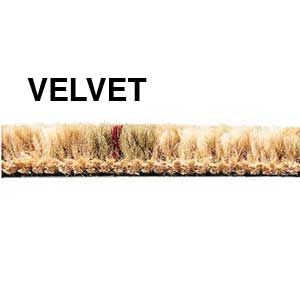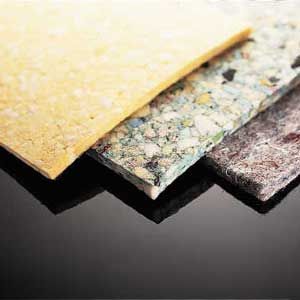Choosing carpet involves more than running your hand across a few samples to find the one you like the most. You need to learn about different fiber types, padding, and durability versus cost. Our guide will walk you through the process and what to look for to help you make an informed decision.
Types of Carpet Fibers
The type of fiber used plays a huge role in carpet’s performance, appearance, and durability. Here are the five main categories.
Wool
Wool is considered the gold standard for carpet fibers. It’s softer than synthetic materials, exceptionally durable, and highly resistant to stains. However, its luxury comes at a price, typically ranging from $4–$20 per square foot.*
Nylon
Nylon is a close second to wool in terms of durability and feel, but it’s more affordable at $2–$5 per square foot. It offers excellent soil resistance, colorfastness, and resilience, making it a popular choice for high-traffic areas.
Olefin
Also known as polypropylene, olefin is both durable and water-resistant. It’s an excellent choice for berber carpets (low, loop-pile carpeting) and indoor/outdoor applications. Olefin typically costs $1–$3 per square foot.
Polyester
Polyester is known for its soft texture, mold-resistance, and good color retention. While not as resilient as nylon, it’s a great option for areas with moderate foot traffic. Expect to pay $1–$3 per square foot for polyester carpeting.
Acrylic
Acrylic offers the look and feel of wool at a lower price point of $3–$8 per square foot. However, it’s prone to fuzzing and pilling, making it less suitable for large carpeted areas.
*Cost data in this article was sourced from Angi.com.
Carpet Styles and Their Suitability
Carpet styles are determined by how the fibers are cut and looped, and each kind works best in different areas of the home.
Loop-Pile Carpets


These carpets have uncut yarn tips, creating a durable surface that’s ideal for high-traffic areas. There are two main types:
- Level loop: Woven tightly to the ground and creates a uniform, textured appearance
- Multilevel loop: Has varying loop heights, creating a more dynamic look
Cut Pile Carpets

These have exposed yarn tips, resulting in a softer, more luxurious feel. Popular cut-pile styles include the following:
- Velvet: Creates a formal, uniform surface
- Saxony: Features longer, slightly twisted fibers for added durability
- Frieze: Has the longest, highly twisted fibers for a more casual look
Cut-Loop Pile
This style combines cut and looped fibers to create patterns and textures. It’s an excellent choice for family rooms and other high-traffic areas, as it hides wear and footprints well.
Factors Affecting Carpet Quality and Durability
When shopping for carpeting, consider these key factors that impact overall quality and longevity.
Face Weight
Face weight refers to the weight of the carpet pile per square yard. “A higher face weight means more yarn, and more yarn makes for a longer-lasting product,” says Dave Grable of Carpet One/Carpet Shack.
Density and Stitches Per Inch
Carpet density, often measured in stitches per inch (SPI), can relate directly to quality. However, be cautious of relying solely on this metric, as standards vary widely among different styles and fibers.
Warranty
“The simplest indication of durability is the warranty,” says Grable. Look for 7- to 10-year wear and stain warranties, and pay attention to the fine print regarding coverage and proration.
Choosing the Right Carpet Padding
Carpet padding is crucial for comfort, insulation, and extending the life of your carpet.

Types of Carpet Padding
Common types of carpet padding include:
- Bonded or rebonded: A good compromise of quality and price
- Natural and synthetic fiber: Most dense and resilient, but also most expensive
- Prime urethane: Least expensive, but prone to compression
Thickness and Density Considerations
The right padding thickness and density depend on your carpet type and how often the room is used. “An extra-thick pad can cause the carpet to flex too much, opening seams and weakening the backing. A pad that’s too thin can collapse and cause the carpet to wrinkle or wear out prematurely,” says Gary Johnson, a technical consultant at the Carpet & Rug Institute (CRI).
Matching Padding to Carpet Type
Check with your carpet dealer to make sure you’re choosing the best padding for your specific carpet and room requirements. The Carpet Cushion Council and the CRI have developed padding specifications based on room traffic to help guide your choice. Living rooms, bedrooms, and dens can handle thicker padding up to 7/16 inch thick and no less than 1/4 inch with 6 pounds per cubic feet density. For berber or low-profile carpets, opt for thinner padding of no more than 3/8 inch thick with 8 pounds density.
Professional Carpet Installation Process
While some homeowners may consider installing carpeting themselves, we highly recommend professional installation for the best results. Here’s a look at the process.
Preinstallation Measurements and Planning
A pro will take accurate measurements and create a floor plan that minimizes waste and strategically places seams. “Pay attention to the location of the seams. Few seams are invisible, but they can sometimes be positioned under furniture or out of major traffic patterns,” says Emad Ghanim, a carpet mechanic.
Furniture Removal and Old Carpet Disposal
Most installers will handle moving furniture and removing old carpets. However, you may be able to save on costs by doing this yourself.
Tack Strip Installation and Carpet Stretching
An expert will then secure tack strips around the room’s perimeter and will likely use a power stretcher for rooms larger than 10-by-10 feet. “A power stretcher, which can be expanded to span a room, allows greater leverage. And that means less buckling later on,” Ghanim says. The expert will then install the carpet, and a good technician will make sure the seams are nearly invisible.
Upkeep For Your Newly Installed Carpet
Regular maintenance is important for preserving your carpet and helping it to last longer. Here are some general guidelines.
Cleaning Techniques
Vacuum your carpet at least once a week, and more frequently in high-traffic areas. Use a vacuum with adjustable height settings for different pile heights.
Dealing with Stains and Spills
Address spills immediately by blotting (not rubbing) the carpet with a clean, white cloth. For stubborn stains, consult your carpet manufacturer’s cleaning guidelines.
Professional Cleaning Recommendations
To maintain your carpet’s appearance and keep your home hygenic, have it professionally cleaned every 12–18 months or as recommended by the manufacturer.
Carpet Considerations for Allergy Sufferers
If you have allergies or chemical sensitivities, pay special attention to these factors when deciding on carpet.
- Low-emission carpets: Look for carpets with the CRI’s Indoor Air Quality (IAQ) emission label, which identifies products that meet stricter indoor air quality requirements.
- Installation precautions for sensitive individuals: If you’re sensitive to chemicals, stay away during the removal and installation process. Ask installers to vacuum the old carpet before removal and clean the floor prior to new carpet installation.
- Post-installation air quality management: After installation, keep windows and doors open for at least 72 hours to allow proper ventilation and off-gassing of new carpet odors.
Carpet Trends and Innovations
The carpet industry is constantly innovating. Here are some new trends you may want to consider investing in.
Eco-Friendly Options
Today, many consumers are environmentally conscious. Carpet manufacturers now offer eco-friendly options made from recycled materials, natural fibers, or sustainable resources. These carpets are both stylish and sustainable.
Advanced Stain Resistance
New treatments and technologies make modern carpets more stain-resistant than ever. This can be a game-changer for households with kids and pets. Advanced stain resistance can extend the life of your carpet and maintain its appearance and durability.
Smart Carpets
While still emerging, smart carpets equipped with sensors to track movement and detect falls are on the horizon. These innovations could transform carpeting into a more functional and even safer part of your home.
Seasonal Tips for Carpet Maintenance
Carpet care isn’t just a one-size-fits-all approach. Seasonal strategies can help maintain your carpet year-round.
Spring and Summer
During spring cleaning, make sure your carpet gets a deep cleaning. Open windows and let fresh air circulate to reduce trapped odors. In summer, humidity can cause issues like mold and mildew, so use dehumidifiers and make sure spills are dried immediately.
Fall and Winter
Fall is a great time to prepare your carpets for the increased foot traffic of the holiday season, so get ahead of it by scheduling a professional cleaning. In winter, manage the impact of snow and salt by placing mats at entrances and regularly cleaning them.

